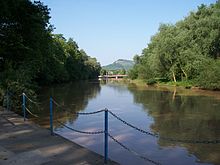
Jena is a city in Germany and the second largest city in Thuringia. Together with the nearby cities of Erfurt and Weimar, it forms the central metropolitan area of Thuringia with approximately 500,000 inhabitants, while the city itself has a population of about 110,000. Jena is a centre of education and research; the university was founded in 1558 and had 18,000 students in 2017 and the Ernst-Abbe-Fachhochschule Jena counts another 5,000 students. Furthermore, there are many institutes of the leading German research societies.

The Únětice culture, Aunjetitz culture or Unetician culture is an archaeological culture at the start of the Central European Bronze Age, dated roughly to about 2300–1600 BC. The eponymous site for this culture, the village of Únětice, is located in the central Czech Republic, northwest of Prague. There are about 1,400 documented Únětice culture sites in the Czech Republic and Slovakia, 550 sites in Poland, and, in Germany, about 500 sites and loose finds locations. The Únětice culture is also known from north-eastern Austria, and from western Ukraine.

A horseshoe curve is a class of climbing curve in a roadbed that reverses turn direction (inflection) twice on either side of a single tight curve that varies through an angle of about 180 degrees or more.

The Tumulus culture was the dominant material culture in Central Europe during the Middle Bronze Age.

The Clear Range is a small mountain range located in the angle of the Fraser and Thompson Rivers in south-central British Columbia, Canada. It has a small subdivision just northeast of that confluence named the Scarped Range. The Clear Range totals 16,270 km2 (6,280 sq mi) and is 75 km (47 mi) north to south and 35 km (22 mi) east to west. The Clear Range and its northward neighbour the Marble Range are both subranges of the Pavilion Range.

The Ottomány culture, also known as Otomani culture in Romania or Otomani-Füzesabony culture in Hungary, was an early Bronze Age culture in Central Europe named after the eponymous site near the village of Ottomány, today part of Sălacea, located in modern-day Bihor County, Romania. The Middle Bronze Age period of the Ottomány culture in eastern Hungary and western Romania is also known as the Gyulavarsánd culture.

The North Shore Mountains are a mountain range overlooking Vancouver in British Columbia, Canada. Their southernmost peaks are visible from most areas in Vancouver and form a distinctive backdrop for the city.

Tŝ’ilʔoŝ, also known as Mount Tatlow, is one of the principal summits of the Chilcotin Ranges subdivision of the Pacific Ranges of the Coast Mountains of southern British Columbia. Standing on an isolated ridge between the lower end of Chilko Lake and the Taseko Lakes, it is 3,063 m (10,049 ft) in elevation.

The Ipf is a mostly treeless mountain, near Bopfingen, Ostalbkreis, Baden-Württemberg, Germany, with a prehistoric hill fort on its top.

Picws Du is the second highest peak of the Carmarthen Fans in the Carmarthenshire section of the Black Mountain in the west of the Brecon Beacons National Park in south Wales. The highest peak is Fan Foel immediately next along the ridge and it is a subsidiary summit of Fan Brycheiniog. Picws Du falls within Fforest Fawr Geopark and its prominent summit is marked by a large Bronze Age round barrow at a height of 2457 feet above sea level. Waun Lefrith is the other, lower summit of the Carmarthen Fans situated to the west. The peak overlooks the glacial lake of Llyn y Fan Fach in the cwm below. As the peak sits on the edge of the escarpment on a ridge which juts out into the valley below, the views from the summit are panoramic and extensive. The views to the north are especially impressive when the weather is clear, looking towards the Cambrian Mountains, Mynydd Epynt and Brecon. Swansea and the Bristol Channel can just be seen on the horizon to the south, across the gently falling dip slope. Pen y Fan and Corn Du are distinctive landmarks seen directly to the east across Fforest Fawr.

At 971 m above sea level (NN) the Wurmberg is the second highest mountain in the Harz and the highest in Lower Saxony (Germany).

The Prehistory of Transylvania describes what can be learned about the region known as Transylvania through archaeology, anthropology, comparative linguistics and other allied sciences.

The Wöllmisse is a high plateau which rises east of the Saale Valley in the State of Thuringia, Germany. The densely wooded Wöllmisse borders the Roda Valley in the South, the Saale Valley to the West, the Gembdenbachtal in the North, and the town of Bürgel and the Gleistal Valley in the East. In Bürgel, it is connected via a saddle with the formation of Jenzig-Hufeisen-Alte Gleisberg.
Vlashnjë is a village in the Prizren municipality of Kosovo. It has 1,700 inhabitants as of 2011. Vlashnjë is a multi-layered settlement and site area. Archaeological excavations have identified habitation and use of the area since the Neolithic era. The rock art paintings at Mrrizi i Kobajës are the first find of prehistoric rock art in Kosovo. In late antiquity, Vlashnja was a fortified settlement part of the fortification network which Justinian I rebuilt along the White Drin in Dardania.

Vassallaggi is a Sicilian prehistoric Bronze Age archaeological site, located on the hill of the same name, which had a later flourishing after the 7th century BC as a phrourion (fortress). The site is located in the middle of the Salso river valley, at 704 m above sea level, near San Cataldo in the province of Caltanissetta, in a strategic location for communication between the southern coast of Sicily and the northern part of the island. It has a NE-SW orientation and stretches along in parallel with the SS 122 San Cataldo-Serradifalco.

The burgstall of the Altes Schloss is the site of an old castle near the village of Affalterthal in Bavaria, that was probably built in the High Middle Ages for the nobility. It lies within the municipality of Egloffstein in the Upper Franconian county of Forchheim.
The Korazim Plateau, is a volcanic plateau, located in northern Israel. The plateau is bounded between by the Hula Valley in the north, Sea of Galilee in the south, the mountains of the Galilee to the west and by the Jordan River to the east. It is named after an ancient Jewish settlement also known as "Chorazin". The highest point is Filon Hill, which is 409 meters above sea level.

Bocksberg is a levelled, medieval hilltop castle on the top of the cone-shaped hill of Bocksberg in the Rhön Mountains near Geisa and Schleid.
Lobeda is a former independent city in Thuringia, Germany, which is now a district of Jena known as Lobeda-Old Town. It was incorporated in 1946, has just under 2000 inhabitants on an area of 3.36 square kilometers and is located just under 4.5 kilometers south of the city center.

Johannisberg is a prominent ridge of the Wöllmisse, a Muschelkalk plateau east of Jena. The steeply sloping spur of land to the Saale Valley north of the district of Alt-Lobeda bears the remains of two important fortifications from the late Bronze Age and the early Middle Ages. Due to several archaeological excavations and finds recovered since the 1870s, they are among the few investigated fortifications from these periods in Thuringia. Of particular interest in archaeological and historical research is the early medieval castle. Due to its location directly on the eastern bank of the Saale, its dating and interpretation were and are strongly linked to considerations of the political-military eastern border of the Frankish empire. It is disputed whether it was a fortification of independent Slavic rulers or whether it was built under Frankish rule. According to a recent study, it may have been built in the second half of the 9th century in connection with the establishment of the limes sorabicus under Frankish influence.



















